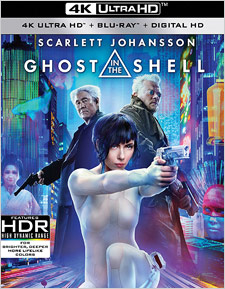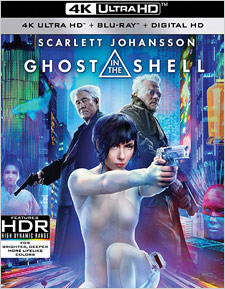Ghost in the Shell (2017) (4K UHD Review)

Director
Rupert SandersRelease Date(s)
2017 (July 25, 2017)Studio(s)
DreamWorks/Reliance/Huahua/Shanghai (Paramount)- Film/Program Grade: B-
- Video Grade: A
- Audio Grade: A
- Extras Grade: B-
Review
Based on the landmark 1995 science fiction anime of the same name by Mamoru Oshii (reviewed on Blu-ray here), and of course the original 1989 manga by Masamune Shirow, Rupert Sanders’ live action Ghost in the Shell is centered on Major Mira Killian (Scarlett Johansson), a young woman involved in an accident that’s left her body irreparably damaged. Her brain is thus placed into an experimental cybernetic body by Dr. Ouelet (Juliette Binoche), a body that’s the property of Hanka Robotics. Subsequently assigned to Public Security Section 9 under the command of Chief Aramaki (played by the great Takeshi Kitano, aka “Beat” Takeshi), the Major leads an anti-terrorism assault team that’s investigating a string of assassinations of Hanka scientists. But the Major’s involvement soon attracts the attention of the murderer, a mysterious hacker known as Kuze (Michael Carmen Pitt). And as the Major gets deeper into her investigation, with the help of her partner Batou (Pilou Asbæk, of Game of Thrones fame) and the rest of her Section 9 friends, she begins to realize that Dr. Ouelet has been lying to her, and that Kuze might be the key to unlocking the truth about her past.
As a live action adaptation, Sanders’ version of GitS is surprisingly credible. There’s not a lot that’s genuinely new here, but the key change – involving the Major’s search for her true identity (in the anime she’s called Motoko Kusanagi right from the start) – does add something interesting to the story by giving the Major a personal investment in the outcome of her investigation. Much has been made (here in the States, at least) of the fact that Scarlett Johansson was cast as the Major instead of a Japanese actress, raising the specter of “whitewashing”. That is certainly a valid complaint in one sense, though it should be noted that the choice wasn’t a controversy in Japan, where audiences already understood that the film deals with issues of blurring identity through artificial means. In that sense, Johansson’s casting actually works for the story. What’s more, Oshii gave his own blessing to the casting choice. In any case, Johansson is actually fairly good in the role, and Takeshi, Binoche, Pitt, and Asbæk all deliver good, if restrained, performances that add nicely to the film’s tone and texture.
There are, however, a couple of choices made that don’t work so well here. For one thing, the Major starts the anime with much more humanity that she does in this film. In the anime, she’s comfortable with who she is, whereas here she’s very stiff – not exactly robotic but definitely emotionally detached and all business – until she begins to discover the truth about her origins. This makes Johansson’s version of the character a bit less empathetic early on. On a similar note, Sanders’ unnamed metropolis is gray and gloomy, owing far more to Los Angeles 2019 from Blade Runner than the animated New Port City, which seemed bright, colorful, and lived in by comparison. This makes the physical world of the film nearly as artificial as the virtual one the Major frequently “ghosts” into. That’s odd, because some of the film was actually shot on location in Hong Kong. It’s just been color-timed to look very cold. The film’s visual effects actually exacerbate this issue – they feel like something you’d see in a video game.
In any case, Ghost in the Shell certainly looks great here. The film was shot digitally in the ARRIRAW codec (5K) using ARRI Alexa 65 cameras. It was finished as a 2K Digital Intermediate, which was then upsampled, given an HDR10 color grade, and is presented on Ultra HD in the original 1.85:1 theatrical aspect ratio. Fine detail and texturing are quite impressive for a 2K upsample – a case of higher resolution capture leading to better pixels downstream. The detail improvement over Blu-ray is modest, but it’s there. The HDR results in much dark blacks and more brightly gleaming highlights, both exhibiting enhanced detail. Meanwhile, the colors are a good two steps bolder than those apparent on Blu-ray, as well as richer and far more nuanced. Overall clarity is excellent. This isn’t a reference quality image for the format, but it’s certainly a standout, especially for its HDR.
Primary audio on the 4K disc is available in a fine English Dolby Atmos mix (7.1 Dolby TrueHD compatible) that’s impressive as hell. The soundstage is buttery smooth, broad and immersive, with quiet atmospheric cues that filter in from all around the listening space. Action sequences, on the other hand, deliver maximum punch with great dynamic range, bold staging, lively and aggressive directionality and panning, and an excellent foundation of bass. The film’s score, though not particularly unique, is well blended into the sonic environment. (One can’t help thinking what Daft Punk might have made of this project.) English Descriptive Audio is also available, as are 5.1 Dolby Digital mixes in French, Spanish, and Portuguese. Optional subtitles include English, English SDH, French, Spanish, and Portuguese.
There are no special features on the 4K Ultra HD disc, but the package includes a Blu-ray that offers the film in 1080p, along with the following extras in HD:
- Hard-Wired Humanity: Making Ghost in the Shell (30:05)
- Section 9: Cyber Defenders (11:29)
- Man & Machine: The Ghost Philosophy (10:36)
That doesn’t seem like a lot, and its not, but what you do get is quite good. The informational content is strong, and you’re given a chance to see behind-the-scenes on every major sequence in the film. All of the key actors speak up as well, talking about their characters and the original source material, including Takeshi – which is very cool to see. So points for quality here, if not for quantity. Note that the 4K package also includes a paper insert with a Digital Copy code.
In the end, the live action Ghost in the Shell is better than we might have expected. If you haven’t seen the original anime or read the manga, you might be pleasantly impressed by some of the concepts in play here. Questions of what makes us human and what humans might become as technology advances into the future – these are very Big Ideas indeed. On the other hand, the anime and manga were both groundbreaking masterpieces in their own right, and this film doesn’t rise to anywhere near that same level of artistic achievement. Still, the film is interesting, worth your time, and looks fantastic on 4K Ultra HD. Recommended.
- Bill Hunt
(You can follow Bill on social media at these links: Twitter and Facebook)

